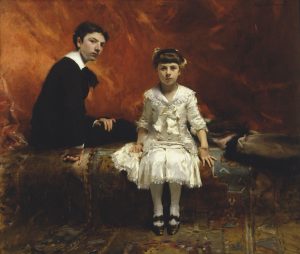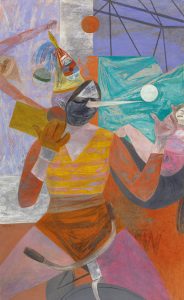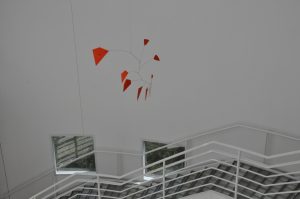One pleasant morning, in the late 1980s, I started my work as the Education Curator at the Des Moines Art Center in Iowa. The phone rang; it appeared we had a problem with an upcoming tour of elementary school children who were also scheduled for a studio-art activity.
Would there be any nudes among the art the children would see in the galleries?
My mind went immediately to the Rodin bronze, a study for his monument to Balzac. I don’t now remember what other artworks were then on display that might offend.
“Well, yes,” I said.
Keeping Blinders On
A little girl in that group was, in fact, not a member of the class but a home-schooler. Her mother, however, leaned on a statute that said home-schoolers were entitled to the same enrichment as the kids in classrooms. Hence, the trip to the art museum. Since we had at least one nude work on display, the child was under no circumstances to go into the museum; she was, on the other hand, to join in on the studio activity.
Crikey, I thought. Actually, I thought much worse words. There was no place for the child to stay for the forty-five minutes or so of the tour. There was no adult to supervise her as the docents and chaperones would have their hands full.
“She can stay with me,” I decided. She was a nice little girl. I don’t remember much about her. Quiet. Well-behaved. And I felt very bad that she was denied the opportunity to see some of the wonderful works that she would have enjoyed. “The Pailleron Children” (1881) by John Singer Sargent. Yasuo Kuniyoshi’s “Amazing Juggler” (1952). The dramatic interior of the new Art Center wing designed by Richard Meier and opened in 1985.
Taking Blinders Off
Naked people. Works of art that included nude figures. We giggled at them when we were young. Our teachers shushed us and our parents shushed us and we quickly realized there was nothing unusual to be seen, nothing intentionally humorous, nothing—you will excuse the expression—titillating. Some of us even began to appreciate art in all its varieties, subjects and mediums.
A Lesson on Renaissance Art
On March 23, an item popped up in Twitter and Facebook. The board of the Tallahassee Classical Charter School in Florida ousted the principal because a teacher had included an image of Michelangelo’s “David” (1504) in a lesson presented to some sixth graders. Two parents objected to not knowing about the lesson in advance. One parent called the presentation “pornographic.” The principal, rather than the classroom teacher or the art teacher, took the fall.
There is a certain irony in this considering that the school celebrates its identity as part of the Barney Charter School Initiative and starts teaching Latin in grade one.
The Barney Charter School Initiative (BCSI) is a project of Hillsdale College devoted to the education of young Americans. Through this initiative, the College supports the launch of K-12 charter schools. These schools will train the minds and improve the hearts of young people through a content-rich classical education in the liberal arts and sciences, with instruction in the principles of moral character and civic virtue.
Reform of American public education, to be successful and good, must be built on a foundation of classical liberal arts learning-the kind of learning best suited to a free society and most needed for it [sic] preservation. BCSI is an important step in that direction.
But then it also has a Fundamentalist Christian substrate to its design. And no budget for proofreading website text.
Pinning Down the Problem
The uproar is the result of The Parental Rights in Education Act (HB 1557), the state law known to its critics as the “Don’t Say Gay” Act. A journalist from Slate Magazine queried Barney Bishop III, chair of the school board, about the events.
Bishop is a partisan of the extremist positions taken by Floriduh Governor Ron DeSantis and the majority-Republican state government. Unsurprisingly, his argument about jettisoning the principal was tortured and irrelevant. To repeated questions from the journalist about whether this particular work, the paradigmatic example of Renaissance idealism, should be taught, he offered the following:
We’re not going to show the full statue of David to kindergartners. We’re not going to show him to second graders. Showing the entire statue of David is appropriate at some age. We’re going to figure out when that is.
And you don’t have to show the whole statue! Maybe to kindergartners we only show the head. You can appreciate that. You can show the hands, the arms, the muscles, the beautiful work Michelangelo did in marble, without showing the whole thing.
Cognitive Dissonance and the State of Floriduh
At no point was there a plan to show David in all his divine perfection to the little ones. There may, however, have been a plan to find a reason to fire the principal.
The work was shown only to sixth graders and Renaissance art is a required subject in the curriculum for that year. Stephanie Hayes, a columnist for the Tampa Bay Times, condemned the episode brilliantly.
It’s worth noting that this school is required to teach Renaissance art in sixth grade. For parents, I don’t see how this can be accomplished without looking at body parts. Artistically speaking, the Renaissance was one big pig roast at Caliente Resorts, OK? The period captured the rise of detailed human forms, lifelike hairs, skin, faces and organs heretofore not rendered in such rich relief! It’s Apollo playing a lute in his birthday suit vibes, do you feel? It’s women wrapped in fig leaves with one boob hanging out, comprehend? Nudity was, perhaps, the biggest art power move of the era, aside from getting snatched up by batlike hell demons while naked. The cherubs better watch out.
Alas, with each moon, Florida schools are being remade into curio cabinets full of creepy Victorian dolls. And that’s sad. Because having a “tee-hee” moment while checking out “St. Jerome in Penitence” and punching Kyle in the shoulder during sixth period is a rite of passage each student deserves.
Undressing the Facts
My own high school education was based on the classical model. Each year, a week in February was devoted to “Civilization of the Western World” classes, events and field trips focused on the arts of the era studied in history and English classes. I am also an art historian and art educator, a person who values the accumulated wisdom of the ancients and the diverse artistic forms left to us across the ages. I am devoted to the ideals of a classical, humanistic education.
Too bad that Floriduh thinks you can have an education without addressing the facts.
PostScript
On March 9, a political science class at Eastern Florida State University was cancelled because one student out of an enrollment of twenty said he was “uncomfortable” with the topic listed in the syllabus: civil rights. Given the draconian penalties enforced by the Parental Rights in Education Act, the professor chose to cancel the class. One student decided the general subject of civil rights was simply too threatening, too much of a trigger. The fears and ignorance of that one snowflake deprived nineteen other students of the opportunity to put their tuition to work and learn about such things.
The future is dark for students and educators, and schools and colleges, in the state of Floriduh.





